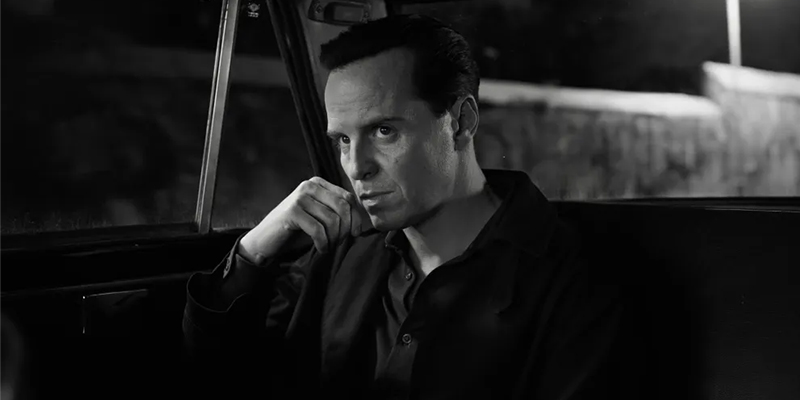The thing about the new Ripley limited series, which premiered on Netflix this week, is that its leading actor, Andrew Scott, is incredibly good. He’s incredibly good in it, and he’s incredibly good in everything. I might even say that he’s the best actor working today. We don’t really need another adaptation of The Talented Mr. Ripley, since we already have Anthony Minghella’s masterpiece from 1999 and René Clément’s Purple Noon from 1960 (not to mention Wim Wenders’s superb 1977 film The American Friend, an adaptation of Ripley’s Game, and two other films, a 2002 Ripley’s Game and a 2005 Ripley Under Ground). All of these have brought us generally excellent Ripleys in the forms of Matt Damon, Alain Delon, Dennis Hopper, John Malkovich, and Barry Pepper, which is to say that, if the new Netflix series hadn’t cast Andrew Scott, I might not have felt such a desperate need to watch.
Developed, written, and directed by Steven Zaillian, Ripley unfolds as a noir, in punchy, digital black-and-white. In the first shot of Andrew Scott’s face, his dark eyes look black and cold, like pools of crude oil. In Ripley, Scott has managed to evacuate almost all humanity and feeling from his body; he embodies the sharp contrast of a body which appears to be human but lacks a human’s soul.
That’s the thing about Scott, who many of us discovered from his turn as the taunting psychopath Moriarty in the BBC Sherlock series, then discovered again as a young priest in crisis, fighting romantic attraction to a woman in Phoebe Waller-Bridge’s Fleabag; not only is he an actor with intense charisma, but he is also uniquely able to command a wide gamut of emotions. Whenever I watch him, I think of those sliding adjustment scales in photo editing software—how one drag of a toggle to the right or left can take the same image and drain it or fill it up with warmth—and I like to imagine, visually, the settings he’s using for that particular performance. In Ripley, that imaginary cursor lies at its farthest axis.
This mode of characterization makes for a compelling antihero, but also feels rather like an intervention in the Ripley canon. Minghella’s The Talented Mr. Ripley is nothing if not emotional; it stars Matt Damon as a young, giddy and thoroughly disturbed interloper who falls in love with a beautiful man and a beautiful lifestyle, and then does whatever he can to preserve whatever he can have of it. It is as heartbreaking as it’s terrifying, a study in explosive pathos and even, maybe, how the pursuit of community only results in greater loneliness. But the novel, written in 1955 by Patricia Highsmith, offers us a slicker, slimier sociopath. We’ve seen an unfeeling Ripley before, but not in a while, and not as well as the one Andrew Scott offers to us, which is an awkward but conniving lizard-man.
The series begins in New York, in the 1960s, where Tom Ripley works daily as a small-time con man; running a faux collection agency designed to defraud ordinary folks of small amounts. He’s tracked down by a private detective (Bokeem Woodbine) hired by the shipping magnate Herbert Greenleaf (Kenneth Lonergan), who has heard that he knows his wayward son Dickie (Johnny Flynn). Dickie has been on a permanent vacation in Italy for years, spending money, lying on the beach, and “working” as a “painter,” and his father thinks it’s high time he returns to face his responsibilities. He sends Tom, all expenses paid, to Italy to retrieve him. But, of course, when Ripley arrives there and gets a taste of Dickie’s lifestyle, he decides to stay indefinitely, at whatever cost.
It’s not exactly that he loves the coastal Italian village that Dickie lives in, or feels any particular fondness for the quirky Italian denizens; if anything, he seems more annoyed and inconvenienced by everything around him. He’d almost seem motivationless in his clear evil if it weren’t for the ways his darting eyes catch objects he likes, things he wants. Maybe Ripley doesn’t think Dickie deserves such objects. Maybe Dickie is one of those objects.
Dickie is a little put-off by Tom’s weird vibe—over-serious, graceless, a bit gauche—but Dickie’s American writer companion, his sort-of-girlfriend Marge Sherwood (Dakota Fanning), is both suspicious and disapproving of the new addition to their group. And Ripley is jealous of Freddy Miles (Eliot Sumner), a wealthy friend of Dickie’s who starts to crash their outings. The more people enter the picture, the more tense things become. If you know anything about the character, you know that Ripley will become a serial killer, slowly and systematically getting rid of anyone who stands in his way as he climbs towards the things he desires.
Ripley is extremely paranoid, another of the extant themes from Highsmith’s novel, but rather than that being some indication of repressed morality or a cosmic punishment for his sins, it feels more like simply another facet of his chemical makeup, one that always prioritizes his own interests. Just because he’s aware of his own criminality doesn’t mean he has any regrets or hesitations. At all.
I like the cinematography and overall production style of Ripley. For a story that spends so much time on aesthetics, from Dickie’s art hobby to the natural, rugged beauty of the locations, it’s striking that it’s all in such crisp black, white, and gray. But it makes sense; it’s a reduced, focused, gelid lens. It’s how Ripley sees the world. The sharpness of the contrast around material objects emphasizes the things that are important to him, while the azure waves and empyrean skies of Southern Italy melt into uninteresting grayscale.
More than that, though, the show plays great attention to the right kinds of details, particularly “systems.” For example, there’s a difference between the pristine machinations of the post-office, the place where Ripley feels at home scheming, and the chipping, endless stairs of Italy, where Ripley must get his bearings to mount his gambit.
Watching him do all this isn’t so much thrilling as it is riveting; there’s no emotional reason to connect to the character, which in some ways almost makes him more watchable. He’s something of a riddle, rather than a surrogate; he’s a living black hole, an unknowable entity, mesmeric for his impersonal capacity for dismantling and swallowing the world around him.

















